| Bofors 40 mm gun | |
|---|---|
 Bofors 40 mm/L60. This example includes the British-designed Stiffkey Sight, being operated by the aimer standing to the right of the loader (turned sideways). It operates the trapeze seen above the sights, moving the sights to adjust for lead. | |
| Type | Autocannon |
| Place of origin |
|
| Service history | |
| In service | 1934–present |
| Used by | See users |
| Wars | World War II, Indo-Pakistani wars and conflicts, Arab-Israeli conflict, Korean War, Indonesia-Malaysia confrontation, Vietnam War, South African Border War, Falklands War, Gulf War, Iraq War |
| Production history | |
| Designer | Bofors |
| Designed | 1930 |
| Manufacturer |
Bofors (1932–2006) BAE Systems AB (2006 onwards) |
| Produced | 1932–present |
| Variants | See 40 mm L/70 |
| Specifications | |
| Mass |
L/60: 1,981 kg (4,367 lb) |
| Crew | dependent on use |
|
| |
| Shell |
Complete round: - L/60 40x311mmR (1.57 in), L/70 40x364mmR |
| Caliber | 40 mm L/60-70 (actual caliber varies from 56-70, based on model) |
| Carriage | 522 kg (1,151 lb) |
| Elevation |
L/60: -5°/+90°(55°/s) L/70: -20°/+80°(57°/s) |
| Traverse |
Full 360° L/60: 50°/s L/70: 92°/s |
| Rate of fire |
L/60: 120 round/min L/70: 330 round/min |
| Muzzle velocity |
L/60: 881 m/s (2,890 ft/s) L/70: 1,021 m/s (3,350 ft/s) |
| Maximum firing range |
L/60: 7,160 m (23,490 ft) L/70: 12,500 m (41,000 ft) |
The Bofors 40 mm gun is an anti-aircraft autocannon designed by the Swedish defence firm of Bofors. It was one of the most popular medium-weight anti-aircraft systems during World War II, used by most of the western Allies as well as various other forces. It is often referred to simply as the Bofors gun.
40 mm L/60
Development
The Swedish Navy purchased a number of 2 pounder Pom-Poms from Vickers as anti-aircraft guns in 1922. However the Navy eventually soured on the Pom-Pom and approached Bofors about the development of a more capable replacement.
Bofors was initially reluctant, as the Swedish Navy was a fairly small market, but when the Navy agreed to pay for the development of a prototype, a contract was signed in late 1928. Bofors responded with a gun that was, to some extent, a smaller version of a 57 mm (6-pounder) semi-automatic gun developed as an anti-torpedo boat weapon in the late 1900s by Finspong before Bofors drove them out of business. Their first test gun was in fact a re-barreled Nordenfelt version of the Finspong gun, to which was added a semi-automatic loading mechanism.
Testing of this gun in 1929 demonstrated that the major problem was feeding the weapon in order to maintain a reasonable rate of fire. A mechanism that was strong enough to handle the stresses of moving the large round was too heavy to move quickly enough to fire rapidly. One interesting attempt to solve this problem used zinc shell cases that burned up when fired. This proved to leave heavy zinc deposits in the barrel, and had to be abandoned. In the summer of 1930 they began experimenting with a new test gun that did away with controlled feed and instead flicked the spent casing out the rear whereafter a second mechanism reloaded the gun by "throwing" a fresh round from the magazine into the open breech. This seemed to be the solution they needed, improving firing rates to an acceptable level, and the work on a prototype commenced soon after.
During this period Krupp purchased a one-third share of Bofors. Krupp engineers started the process of updating the Bofors factories to use modern equipment and metallurgy, but the 40 mm project was kept secret. Nevertheless, many sources claim that the 40 mm design was in fact adapted from a Krupp weapon. However the only German weapon of similar caliber (and role) was the 3.7 cm FlaK 43, made by Rheinmetall; it appears that historians have connected the development of the Bofors 40 mm and German 37 mm weapons without any supporting evidence. It should be pointed out these two weapons are quite different from each other and share few, if any, features.
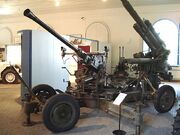
Finnish Bofors 40 mm. This gun mounts the original reflector sights, and lacks the armor found on British examples.
The prototype was completed and fired in November 1931, and by the middle of the month it was firing strings of two and three rounds. Changes to the feed mechanism were all that remained, and by the end of the year it was operating at 130 rounds per minute. Continued development was needed to turn it into a weapon suitable for production, which was completed in October 1933. Since acceptance trials had been passed the year before, this became known as the 40 mm akan M/32. Most forces referred to it as the Bofors 40 mm L/60, although the barrel was actually 56.25 calibers in length, not the 60 calibers that the name implies.
The gun fired a 900 g (2.0 lb) high explosive 40 × 311R (rimmed) shell at 850 m/s (2,800 ft/s). The rate of fire was normally about 120 rounds per minute (2.0 rounds per second), which improved slightly when the barrels were closer to the horizontal as gravity assisted the feeding from the top-mounted magazine. In practice firing rates were closer to 80–100 rpm (1.3-1.7 rounds per second), as the rounds were fed into the breech from four round clips which had to be replaced by hand. The maximum attainable ceiling was 7,200 m (23,600 ft), but the practical maximum was about 3,800 m (12,500 ft).
The gun was also notable due to its advanced sighting system. The trainer and layer were both provided with reflector sights for aiming, while a third crew-member standing behind them "adjusted" for lead using a simple mechanical computer. Power for the sights was supplied from a 6$4 battery.

Polish-made Bofors gun after the Battle of the Bzura. This gun also mounts the reflector sight that equipped the original Bofors versions.
With the design now reaching completion, the Swedish Navy once again decided it needed a smaller hand-swung weapon of 13 mm-25 mm size, and started testing various designs from foreign suppliers. With the 40 mm well along in development, Bofors offered a 25 mm version in 1932, which was eventually selected as the 25 mm akan M/32. The first version of the 40 mm the Navy ordered was intended for use on submarines. The barrel was shorter at 42 calibers long, with the effect of reducing the muzzle velocity to about 700 m/s (2,300 ft/s). When not in use, the gun was pointed directly up and retracted into a watertight cylinder.
The first order for the "real" L/60 was made by the Dutch Navy, who ordered five twin-gun mounts for the cruiser De Ruyter in August 1934. These guns were stabilized using a unique system known as the Hazemeyer mount, in which one set of layers aimed the gun, while a second manually stabilized the platform the gun sat on. All five mounts were operated by one fire control system.
Bofors also started the development of a suitable towable carriage which they displayed in April 1935 at a show in Belgium. The carriage caused something of a stir, as the gun could be fired from the carriage with no setup required, although with limited accuracy. If time was available for setup, the gunners used the tow-bar and muzzle lock as levers, raising the wheels off the ground and thereby lowering the gun onto supporting pads. Two additional legs folded out to the sides, and the platform was then leveled with hand cranks. The entire setup process could be completed in under a minute.
Orders for the land based versions were immediate, starting with an order for eight weapons from Belgium in August 1935, and followed by a flood of orders from other forces including Poland, Norway, and Finland. It was only accepted into the Swedish Army the next year, known as the 40 mm lvakan m/36, the lower-case m indicating an Army model as opposed to the capital M for Navy.
British versions
Army versions

Q.F. 40 mm Mk. 1 displayed at CFB Borden. This example mounts a Stiffkey Sight, and displays the additional armor protecting the gunners.

The gunner's seat of an Australian Bofors gun used in World War II and now housed in a Sydney war museum
The British Army had first examined the weapon when they received a number of Polish-built examples in 1937 for testing, known as the QF 40 mm Mark I (QF standing for "Quick Firing"), or Mark I/2 after a minor change to the flash hider. A license was soon acquired and the arduous task of converting the gun from metric to imperial measurements was started. While this was taking place they also made numerous changes to the design to make it more suitable to mass production—the original Bofors design was intended to be hand-assembled, and many parts were labeled "file to fit on assembly", requiring many man-hours of work to complete.
Testing showed that aiming the guns was a serious problem against high-speed aircraft. Although the gun could be trained quickly, aiming accurately while doing so proved difficult. In order to address this, the British introduced a complex mechanical analogue computer, the Kerrison Director, which drove the laying electrically. A three-man team operated the Director simply by pointing it at the target and dialing in estimates for range and various atmospheric conditions. The Director then aimed the guns directly through powered mounts, the gunners simply loaded the clips and watched. Backup sights were fitted to the individual guns, replacing the former reflector sight and lead-calculator with a simple ring-and-post sight known as a "pancake".
In this form, the QF 40 mm Mark III (there was no Mk II), became the Army's standard light AA (anti-aircraft) weapon, operating alongside their 3-inch and 3.7-inch heavy weapons. The gun was considered so important to the defence of England after the fall of France in 1940 that a movie, The Gun, was produced to encourage machinists to work harder and complete more of them. By the end of the war total production from British, Canadian, and Australian factories was over 2,100, while U.S. lend-lease examples added about 150.
In combat it was found that the Kerrison was simply too difficult to set up to use in many situations, as well as making logistics more complex due to the need to keep its electrical generator supplied with fuel. In most engagements only the pancake sights were used, without any form of correction, making the British versions less capable than those used by other forces. Eventually an anti-aircraft gunnery school on the range at Stiffkey on the Norfolk coast delivered a workable solution, a simple trapeze-like arrangement that moved the pancake sights to offer lead correction, operated by a new crew-member standing behind the left-hand layer. The Stiffkey Sight was sent out to units in 1943, arriving in Canadian units in the midst of the Battle of the Aleutian Islands. A final wartime change to the elevation mechanism resulted in the QF 40 mm Mark XII. They also designed a much lighter two-wheeled carriage for airborne use.
The Army also experimented with various self-propelled AA systems (SPAAGs) based on various tank chassis. Changes to the breech for this role created the QF 40 mm Mark VI, which was used on the Crusader to produce the Crusader III AA Mark I. But the main self-propelled version of the Bofors was with the gun set on the chassis of a Morris Commercial four-wheel drive lorry. Such guns were used in support of Army divisions to provide swift protection against air attack without the need to unlimber. this was known as the "Carrier, SP, 4x4 40mm, AA (Bofors) 30cwt". They saw service in North West Europe, where six SP Bofors of 92nd (Loyals) Light Anti-Aircraft Regiment, Royal Artillery, landed with the British 3rd Infantry Division on Sword Beach on D-Day to protect the vital bridges over the Caen Canal and Orne River (Pegasus Bridge and Horsa Bridge), shooting down 17 German planes. Later in the campaign, SP Bofors were used extensively for ground shots as well as in an anti-aircraft role. In British army service the Bofors found a highly specialised role: during the North Africa Campaign at the Battle of El Alamein, they were used to fire tracer horizontally to mark safe paths for units through the German minefields.
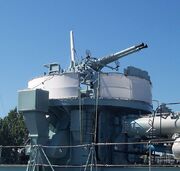
Twin Bofors 40 mm aboard ORP Błyskawica, a WWII destroyer of the Polish Navy.

Single Bofors 40 mm Boffin mounting, displayed at CFB Borden
The Royal Navy also made extensive use of the Bofors. Their first examples were air-cooled versions quickly adapted to ships during the withdrawal from Norway. With the fall of the west in 1940 the Dutch mine-layer Willem van der Zaan brought them their first example of a water-cooled gun on their Hazemeyer tri-axially stabilized mounting. Locally produced examples started arriving in 1942, known as the QF 40 mm Mark IV for use in twin-mounts, or the QF 40 mm Mark V for single mounts. The Navy ran through a variety of versions of the basic Bofors gun over the war, including the Mark VII to Mark XI. The Royal Navy's home-grown light anti-aircraft weapon, the QF 2-pounder gun, also had a caliber of 40 mm, but was referred to as the QF 2 pdr.
The designation of models in Royal Navy service is confused by the fact that the gun and its mounting received separate mark numbers. The following mountings were used;
- Mark I: twin mounting based on American design and using American built guns, not widely fitted. Fitted for remote fire control.
- Mark II: quadruple version similar to Mark I
- Mark III: a navalized version of the Army single mounting, hand worked elevation and training.
- Mark IV: a tri-axially stabilized twin mounting copied from, and usually known as, the "Hazemeyer". It had on-mounting fire control, and was usually fitted with Radar Type 282 to provide target range information.
- Mark V: twin mounting, that superseded and eventually replaced the Mark IV, often referred to as the "utility" mounting. This was a simplified, unstabilised mounting based on the American twin mounting Mark I, and was designed for remote fire control.
- Mark VI: a six-barreled weapon feeding from large trays instead of clips and designed for remote control from a dedicated radar-equipped director.
- Mark VII: a single barreled, hydraulically powered mounting that superseded the Mark III and entered service in 1945.
- Mark IX: Mark VII mount modified to electrical power, as the Mounting Mark IX, and in this form saw service in the Falklands War.
Confusingly, the Mounting Mark V (Mark VC for Canadian built examples) for the 20 mm Oerlikon and QF 2 pounder guns was also adopted as (initially) an interim mount for the Bofors. It was a single barreled mounting with hydraulic power, and was known as the Boffin.
The final British Bofors mounting that saw service was the STAAG. Standing for Stabilized Tachymetric Anti Aircraft Gun this was an enormous twin-barrelled affair that, as the name indicates, was stabilised and carried its own tachymetric (i.e. predictive) fire control system, based around the centimeter Radar Type 262. This latter set was capable of "locking on" to a target. Unfortunately, this mounting was grossly overweight (17.5 tons) and it was found that the high-vibration environment of the gun mounting was a less than ideal location for sensitive valve electronics and mechanical computers. STAAG Mark I carried the radar dish over the gun barrels where it was subject to damage during firing, therefore STAAG Mark II shifted the set to the roof of the control cabin. An ambitious weapon that was ahead of its time, STAAG was ultimately too difficult to maintain in the harsh environment of a warship and was later replaced by the Mounting Mark V with the fire control equipment located remotely, the single Mark VII and ultimately, with the Sea Cat missile.
U.S. versions
[[File:Bofors firing USS Hornet.jpg|thumb|A MK 12 quadruple mount of Bofors guns fires from USS Hornet (CV-12)
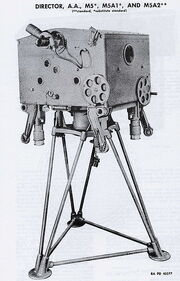
M5 gun director 1944
The United States Navy's Bureau of Ordnance purchased a twin-mount air-cooled example directly from Bofors, which arrived in New York on 28 August 1940. During that month another Dutch ship, the van Kinsbergen, demonstrated the Hazemeyer mount to Navy observers. The gun was quickly chosen as the Navy's standard anti-aircraft weapon, and the Navy secretly imported a set of Imperial designs from England and started production illegally. A formal contract with Bofors followed in June 1941. The resulting Mark 1 and Mark 2 weapons were intended for the left and right side of a twin mount, respectively. It was eventually replaced by the 3"/70 Mark 26 gun due to its problem with kill-stopping Japanese kamikaze aircraft.
Army
The United States Army had recently introduced a 37 mm gun of their own design, but found it to be of limited performance. Six British Bofors were imported for testing, along with the Kerrison Directors, and proved to be superior in all areas. In order to supply both the Army and Navy with much greater numbers of the guns, Chrysler was brought in to be a major producer. Over the lifetime of the production, their engineers introduced numerous additional changes to improve mass production, eventually reducing the overall time needed to build a gun by half. In U.S. Army service, the Bofors was known as the 40 mm Automatic Gun M1. The U.S. version of the gun fired three variants of the British Mk. II high-explosive shell as well as the M81A1 armor-piercing round, which was capable of penetrating some 50 mm of homogeneous armor plate at a range of 500 yards.
Captured examples
The Wehrmacht used a number of Bofors guns which had been captured in Poland and France. The Kriegsmarine also operated some guns obtained from Norway.
Japan captured a number of Bofors guns in Singapore and put them into production as the Type 5.
Both Japan and (West) Germany continued to use the Bofors gun throughout the Cold War.
Continued use
[[File:Bofors-060323-F-9044H-001.JPG|thumb|Crewmen loading ammunition in the Bofors of a Lockheed AC-130]] Although the L/60 was later replaced in production by the L/70, the L/60 remained in front-line service well into the 1980s. In most cases these were the ground antiaircraft versions, as a suitable replacement in this role did not come along until the introduction of truly effective MANPADS missiles in the 1980s. L/60s are still used in the United States Air Force's AC-130 gunships in the air-to-ground role.
The L/60 saw active service with the Argentine and British Navies in the 1982 Falklands War and continued to be used into the 1990s, when it was replaced by modern 20-mm and 30-mm artillery.
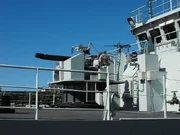
The L/60 Bofors fitted to the Kingston-class coastal defence vessel HMCS Nanaimo (MM 702)
The Canadian Forces also used Bofors on their surface fleet, but removed the guns in the late 1980s when they were considered to be outdated. In a somewhat embarrassing episode, the navy was forced to scour various military museums across Canada to re-equip their fleet during the Gulf War, as replacements had never been purchased. The L/60 Bofors continue to be the main armament of the Kingston-class coastal defence vessel, although the navy is in the midst of a search for a suitable replacement.[1]

Twin L/60 dismounted from an Argentine corvette which saw service during the Falklands war
In August 2006, the French navy uses L/60s on more than twenty ships (patrols and auxiliaries). Ships of the Norwegian and Icelandic Coast Guards continue to use the 40mm Bofors gun. The L/60 continued in use in the Irish Army until recent years, when it was retired in favour of the radar controlled L/70. Three vessels of the Irish Naval Service retain L/60s on board as their main weapon. Two retired L/60s can be seen adjacent the square in Sarsfield Barracks, Limerick.
The last 40 mm/60 Bofors in service with the Royal Australian Navy (RAN) were used as the main weapon aboard the Fremantle-class patrol boats, and for training purposes at the West Head Gunnery Range at HMAS Cerberus.[2] These were removed from service during 2007; Bofors were used aboard almost every RAN ship to operate between the 1940s and the 1990s.[2]
As of 2008, some of Taiwan's anti-aircraft forces are still using the L/60.
40 mm L/70
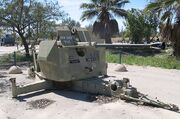
Bofors L/70
By the end of World War II, jet aircraft had so increased the speed of attack that the Bofors simply could not get enough rounds into the air to counter the aircraft before it had already flown out of range. In order to counter these threats, the gun would have to have longer range and a higher rate of fire, thereby increasing the number of rounds fired over the period of an engagement. Bofors considered either updating the 40 mm, or alternately making a much more powerful 57 mm design, and in the end did both.
The new 40 mm design used a larger 40 × 364R round firing a slightly lighter 870g shell at a much higher 1,030 m/s (3,379fps) muzzle velocity. The rate of fire was increased to 240 rounds per minute (4.0 rounds per second), unusually high for such a large round. Additionally the carriage was modified to be power-laid, the power being supplied by a generator placed on the front of the carriage. The first version was produced in 1947, accepted in 1948 as the 40 mm lvakan m/48, and entered Swedish service in 1951. Additional changes over the years have improved the firing rate first to 300 rpm (5.0 rounds per second), and later to 330 rpm (5.5 rps).
Foreign sales started, as they had in the past, with Netherlands and the United Kingdom. In November 1953 it was accepted as the NATO standard anti-aircraft gun, and was soon produced in the thousands. The L/70 was also used as the basis for a number of SPAAGs, notably the U.S. Army's proposed M247 Sergeant York.

Bofors 40 armed Swedish Combat Vehicle 90
Breda (now Oto Melara) of Italy uses Bofors 40 mm L/70 gun in its anti-aircraft weapon systems Type 64, Type 106, Type 107, Type 564 and Type 520. Also they have developed a CIWS system named DARDO for the Italian Army and Navy. A newer development from Breda, the Fast Forty, has nearly doubled the rate of fire to 450 rpm (7.5 rounds per second) (2 × 450 in twin mount), normally equipped with a 736 round magazine and a dual feed mechanism for naval use.
In the Swedish Army Combat Vehicle 90 there is a cartridge fed, automatic version of the L/70 gun installed. In order to fit inside the vehicle, the gun is mounted upside down. New armour piercing and programmable ammunition have also been developed. Germany has used L/70 guns on its Class 352 / Class 333 and Class 332 mine hunting vessels, although these will be replaced by Rheinmetall MLG 27 remote-controlled gun systems until 2008. Until the early 80s L/70 guns guided by D7B radars were in widespread use in the AAA role in the German Navy and Air Force until replaced by Roland SAMs. The L/70 is also chosen as the default main gun for the K21 IFV for the Republic of Korea military.
Users
|
|
See also
References
- ↑ Stephen Priestley. "The Kingston Class: 'Mid-Life' or Move Over for the MCDV?". Canadian American Strategic Review. http://www.casr.ca/id-mcdv-midlife2.htm. Retrieved February 19, 2007.
- ↑ 2.0 2.1 "Last blast for Bofors". Royal Australian Navy. 2007. Archived from the original on 2011-06-13. http://web.archive.org/web/20110613233736/http://www.navy.gov.au/w/index.php/Last_blast_for_Bofors. Retrieved 2009-09-14.
- Notes
- Bibliography
- Campbell, John. Naval Weapons of World War Two. Annapolis: Naval Institute Press, 1985. ISBN 0-87021-459-4.
External links
- [1] TM 9-252
- 40 MM Antiaircraft Gun, OP 820, 1943 : Navy Service Manual placed online courtesy of Historic Naval Ships Association
- Bofors 40 MK3 Naval Gun System - BAE Systems Bofors official site
- Oto Melara small caliber naval products page
- Indian Ordnance 40mm L 70 AA Gun
- Data and Spec comparison of various marks of Bofors 40mm L/60
- Data and Spec comparison of various marks of Bofors 40mm L/70
- http://www.cdsg.org/downloads/40_mm.pdf
The original article can be found at Bofors 40 mm and the edit history here.